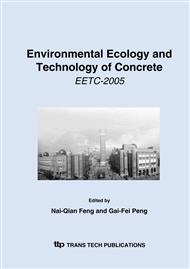[1]
Long Guangchen: Autogenous Shrinkage of Cement-based Materials with Low Water Binder Ratio, China Concrete and Cement Products, 2000, No. 4, pp.3-5.
Google Scholar
[2]
Yang Quanbing: Study on the Self-desiccation of High Performance Concrete Stored in Water for Two Years, Journal of Building Materials, 1998, No. 3, pp.215-221.
Google Scholar
[3]
H.E. Davis: Autogenous Volume Change of Concrete, Proceeding of the 43th Annual American Society for Testing Materials, 1940, pp.1103-1113.
Google Scholar
[4]
Qian Xiaoqian, Zhan Shulin, Fang Minghui: Study and Application on Shrinkage-reducing Agent of High Performance Concrete, New Building Materials, 2003, No. 7, pp.42-45.
Google Scholar
[5]
A. Radocea: Autogenous Volume Change of Concrete at Very Early Age, Magazine of Concrete Research, 1998, No. 2, pp.107-109.
DOI: 10.1680/macr.1998.50.2.107
Google Scholar
[6]
S. Lepage, M. Balbaki, E. Dallaire: Early Shrinkage Development in the High Performance Concrete, Cement, Concrete, and Aggregates, 1999, No. 2, pp.31-35.
DOI: 10.1520/cca10505j
Google Scholar
[7]
E. Tazawa, S. Miyazawa: Experimental Study on Mechanism of Autogenous Shrinkage of Concrete, Cem. Concr. Res. 25 (8) (1995) 1633-1638.
DOI: 10.1016/0008-8846(95)00159-x
Google Scholar
[8]
E. Tazawa, S. Miyazawa: Influence of Cement and Admixture on Autogenous Shrinkage of Cement Paste, Cem. Concr. Res. 25 (2) (1995) 281-287.
DOI: 10.1016/0008-8846(95)00010-0
Google Scholar
[9]
An Mingzhe, Qin Weizu, Zhu Jinquan: Experimental Study on Autogenous Shrinkage of High- Strength Concrete, Journal of Shandong Institute, 1998, No. 12, pp.139-143.
Google Scholar
[10]
Ba Hengjing, Gao Xiaojian, Yang Yingzi: Research on Measuring Means of Autogenous Shrinkage of High Performance Concrete at Early Age, Industrial Construction, 2003, No. 8, pp.1-4.
Google Scholar
[11]
Li Jiahe, Ou Jinping, Sun Wenbo: Effect of Mineral Admixture on Autogenous Shrinkage of High Performance Concrete at Early Age, Concrete, 2002, No. 5, pp.9-11.
Google Scholar
[12]
Li Yue, Wu Keru, et al.: Effect of Additives on the Autogenous Shrinkage of Cement Paste, Journal of Building Materials, 2001, No. 1, pp.7-12.
Google Scholar


